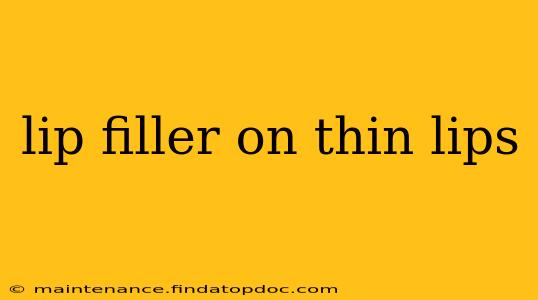Thin lips are a common concern, and many individuals seek lip augmentation to enhance their appearance. Lip fillers have become a popular choice for achieving fuller, more defined lips, offering a non-surgical solution with noticeable results. This comprehensive guide explores the use of lip fillers specifically for thin lips, addressing common questions and concerns.
What are lip fillers, and how do they work on thin lips?
Lip fillers, typically made of hyaluronic acid (HA), are injectable gels that add volume and shape to the lips. When injected into thin lips, the HA filler plumps up the lip tissue, creating a fuller, more voluminous appearance. The results are immediate, though some swelling is normal in the initial days. The HA used in most fillers is biodegradable, meaning the effect is temporary, typically lasting several months before needing a touch-up. A skilled injector can carefully tailor the placement of the filler to address specific concerns, such as improving the Cupid's bow or adding definition to the lip border.
How long do lip fillers last on thin lips?
The longevity of lip fillers varies depending on several factors, including the type of filler used, the individual's metabolism, and the amount injected. Generally, HA fillers for lip augmentation last anywhere from 6 to 12 months. Factors like sun exposure and lifestyle choices can also influence how long the effects last. After the initial treatment, maintaining the results may require repeat injections to keep your lips looking full.
Are lip fillers safe for thin lips?
Lip fillers are generally considered safe when administered by a qualified and experienced medical professional. However, as with any cosmetic procedure, potential risks and side effects exist. These can include swelling, bruising, tenderness, and infection. Selecting a board-certified dermatologist or plastic surgeon is crucial to minimize these risks. A thorough consultation allows the injector to assess your lip structure, skin type, and medical history to determine the best approach and to discuss potential risks. Be sure to ask about their experience with lip augmentation on thin lips specifically.
What are the different types of lip fillers used for thin lips?
While various filler types exist, hyaluronic acid (HA) based fillers are the most common for lip augmentation. These are readily biodegradable and offer predictable results. Specific HA fillers are designed for lip enhancement, taking into account the delicate nature of the lip tissue. Your practitioner will discuss the best options based on your desired outcome and individual needs. Don't hesitate to ask questions about the specific type of filler they intend to use.
How much do lip fillers for thin lips cost?
The cost of lip fillers varies considerably depending on the amount of filler needed, the geographic location, and the practitioner's fees. It's best to schedule a consultation to get a personalized quote. The price typically reflects the type and quantity of filler used. Remember that cost shouldn't be the sole deciding factor; prioritizing the experience and qualifications of the injector is paramount.
What is the recovery process like after lip filler treatment for thin lips?
Immediately following the injection, you might experience some mild swelling, bruising, or tenderness. These side effects are usually temporary and subside within a few days. Ice packs can help manage swelling. Avoid strenuous activities and alcohol consumption for the first 24-48 hours. Your injector will provide detailed post-treatment instructions to ensure optimal healing. Avoid touching or massaging the treated area to minimize the risk of complications.
Can lip fillers make thin lips look unnatural?
The key to achieving natural-looking results is choosing a skilled injector who understands facial anatomy and can carefully tailor the treatment to your individual features. Overfilling can lead to an unnatural appearance. A well-executed procedure should enhance your natural features, creating a subtle and harmonious look. Open communication with your practitioner is essential to ensure you're both on the same page regarding the desired outcome. Show your injector pictures of the look you are trying to achieve, and ensure they understand your vision.
How can I find a qualified injector for lip fillers?
Finding a qualified and experienced injector is crucial for achieving safe and natural-looking results. Look for board-certified dermatologists, plastic surgeons, or other medical professionals with extensive experience in cosmetic injectables. Check online reviews, ask for before-and-after photos, and schedule consultations to discuss your goals and concerns. Don't hesitate to ask about their experience with lip filler on thin lips and their approach to creating a natural look. Remember that safety and a natural-looking result should always be your top priority.
